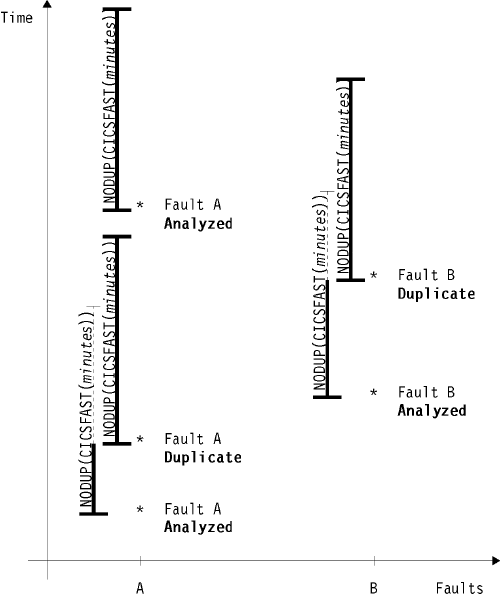NoDup(CICSFAST(…))
This suboption is used to specify the number of minutes elapse time, since the last occurrence of a fault, during which subsequent invocations of Fault Analyzer for other faults in the same job step are deemed duplicates of the last fault if they satisfy the appropriate fault characteristics criteria.
- All instances of
fault A
are considered duplicates of each other based on fault characteristics alone - All instances of
fault B
are considered duplicates of each other based on fault characteristics alone - The
fault A
characteristics do not match those offault B

This option is currently used under CICS® to prevent multiple identical transaction abends that occur within a short period of time from all being analyzed by Fault Analyzer with subsequent risk of exhausting system resources.
The valid range of minutes is 0 - 10080 (10080 is equivalent to one week). Specification of 0 minutes means that "CICSFAST" duplicate faults are not detected.
The default elapse time is 5 minutes.
- Transaction IDs
- CICS® abend codes
- Failing program names
- Request IDs
- System and user sense codes
- Operating system abend codes
- Offsets to the point of error
- PSWs on entry to abend
NoDup(CICSFAST) signatures are kept in the CICS® region.
All fault details are obtained from the transaction abend control block (TACB), except for the transaction IDs. Only TACB fields that are valid for both TACBs are included in the duplicate comparison.
- If a TACB is available, then the duplicate determination is performed on the same basis as for CICS® abends shown above (with the CICS® dump codes used instead of the CICS® abend codes).
- If a TACB is not available, then the duplicate determination is performed on the basis of:
- Transaction IDs
- CICS® dump codes
- Failing program names
When a fault is deemed a duplicate of another based on the fault characteristics and the
NoDup(CICSFAST(…)) option in effect, the writing of the history file entry is
suppressed, the duplicate count associated with the last fault is incremented by one, and message
IDI0066I is issued. This type of fault suppression is referred to as
CICS fast duplicate fault suppression
.
Fault Analyzer provides an exit, IDINDFUE, which can be used to override the duplicate designation of certain faults, based on abend code and other attributes. For details, see CICS NoDup(CICSFAST) override assembler exit (IDINDFUE).
To prevent Fault Analyzer from continuing to designate new occurrences of abends as duplicates of an already deleted fault entry, the NoDup(CICSFAST) recording area should be cleared. For details, see Clearing the NoDup(CICSFAST(…)) recording area.